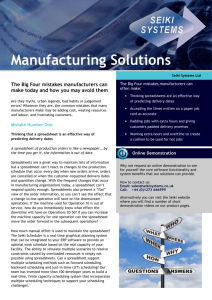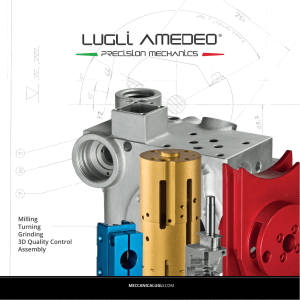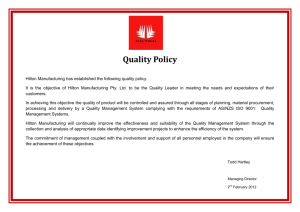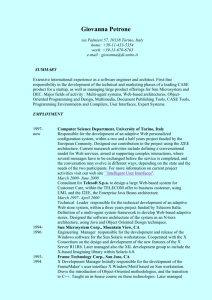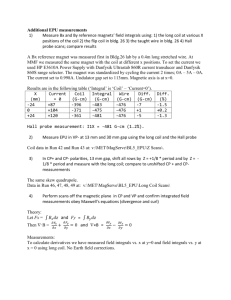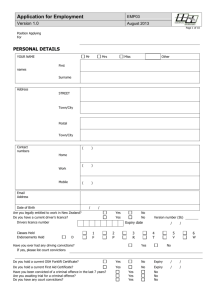Siddall & Hilton Products Case Study
advertisement
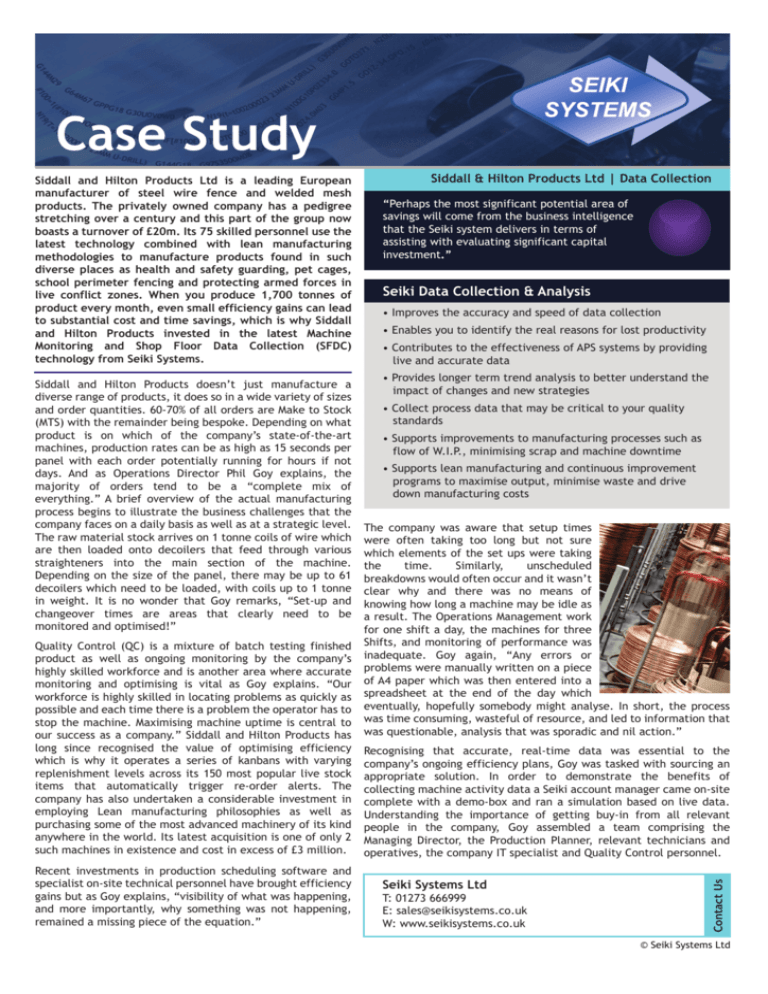
Case Study Siddall and Hilton Products doesn’t just manufacture a diverse range of products, it does so in a wide variety of sizes and order quantities. 60-70% of all orders are Make to Stock (MTS) with the remainder being bespoke. Depending on what product is on which of the company’s state-of-the-art machines, production rates can be as high as 15 seconds per panel with each order potentially running for hours if not days. And as Operations Director Phil Goy explains, the majority of orders tend to be a “complete mix of everything.” A brief overview of the actual manufacturing process begins to illustrate the business challenges that the company faces on a daily basis as well as at a strategic level. The raw material stock arrives on 1 tonne coils of wire which are then loaded onto decoilers that feed through various straighteners into the main section of the machine. Depending on the size of the panel, there may be up to 61 decoilers which need to be loaded, with coils up to 1 tonne in weight. It is no wonder that Goy remarks, “Set-up and changeover times are areas that clearly need to be monitored and optimised!” Quality Control (QC) is a mixture of batch testing finished product as well as ongoing monitoring by the company’s highly skilled workforce and is another area where accurate monitoring and optimising is vital as Goy explains. “Our workforce is highly skilled in locating problems as quickly as possible and each time there is a problem the operator has to stop the machine. Maximising machine uptime is central to our success as a company.” Siddall and Hilton Products has long since recognised the value of optimising efficiency which is why it operates a series of kanbans with varying replenishment levels across its 150 most popular live stock items that automatically trigger re-order alerts. The company has also undertaken a considerable investment in employing Lean manufacturing philosophies as well as purchasing some of the most advanced machinery of its kind anywhere in the world. Its latest acquisition is one of only 2 such machines in existence and cost in excess of £3 million. Recent investments in production scheduling software and specialist on-site technical personnel have brought efficiency gains but as Goy explains, “visibility of what was happening, and more importantly, why something was not happening, remained a missing piece of the equation.” Siddall & Hilton Products Ltd | Data Collection “Perhaps the most significant potential area of savings will come from the business intelligence that the Seiki system delivers in terms of assisting with evaluating significant capital investment.” Seiki Data Collection & Analysis • Improves the accuracy and speed of data collection • Enables you to identify the real reasons for lost productivity • Contributes to the effectiveness of APS systems by providing live and accurate data • Provides longer term trend analysis to better understand the impact of changes and new strategies • Collect process data that may be critical to your quality standards • Supports improvements to manufacturing processes such as flow of W.I.P., minimising scrap and machine downtime • Supports lean manufacturing and continuous improvement programs to maximise output, minimise waste and drive down manufacturing costs The company was aware that setup times were often taking too long but not sure which elements of the set ups were taking the time. Similarly, unscheduled breakdowns would often occur and it wasn’t clear why and there was no means of knowing how long a machine may be idle as a result. The Operations Management work for one shift a day, the machines for three Shifts, and monitoring of performance was inadequate. Goy again, “Any errors or problems were manually written on a piece of A4 paper which was then entered into a spreadsheet at the end of the day which eventually, hopefully somebody might analyse. In short, the process was time consuming, wasteful of resource, and led to information that was questionable, analysis that was sporadic and nil action.” Recognising that accurate, real-time data was essential to the company’s ongoing efficiency plans, Goy was tasked with sourcing an appropriate solution. In order to demonstrate the benefits of collecting machine activity data a Seiki account manager came on-site complete with a demo-box and ran a simulation based on live data. Understanding the importance of getting buy-in from all relevant people in the company, Goy assembled a team comprising the Managing Director, the Production Planner, relevant technicians and operatives, the company IT specialist and Quality Control personnel. Seiki Systems Ltd T: 01273 666999 E: sales@seikisystems.co.uk W: www.seikisystems.co.uk Contact Us Siddall and Hilton Products Ltd is a leading European manufacturer of steel wire fence and welded mesh products. The privately owned company has a pedigree stretching over a century and this part of the group now boasts a turnover of £20m. Its 75 skilled personnel use the latest technology combined with lean manufacturing methodologies to manufacture products found in such diverse places as health and safety guarding, pet cages, school perimeter fencing and protecting armed forces in live conflict zones. When you produce 1,700 tonnes of product every month, even small efficiency gains can lead to substantial cost and time savings, which is why Siddall and Hilton Products invested in the latest Machine Monitoring and Shop Floor Data Collection (SFDC) technology from Seiki Systems. © Seiki Systems Ltd Case Study “This was an essential step in demonstrating the importance of improving the uptime of our resources through improved visibility of machine activity and individual job performance” explains Goy. “I was able to show everyone by fast forwarding through 20 hours of video footage just how many stoppages we were having and how little we knew about each one. This was contrasted with the way the Seiki system monitored every stoppage, the reason for every stoppage, and the ability to then analyse the reasons. “It was clear that Seiki theoretically could do what we needed – all we needed to do was build a capital case to get the go-ahead.” Goy already knew that the company had lost 130 productive shifts on just one machine in the previous year due to changeovers with each shift costing approximately £800. Incremental profit lost due to changeovers approximates £18k. A projected 20% efficiency saving from the Seiki System would therefore be £3.6k p.a. When the same analysis was applied to reductions in scrap and rework it became clear that the company was looking at a Return on Investment (ROI) in under 2 years. And this was only for one machine with each of the other machines having an even quicker ROI due to the expertise that would be acquired in setting up the first machine. Seiki Systems Ltd Olivier House, 18 Marine Parade, Brighton, BN2 1TL T: 01273 666999 F: 01273 602564 E: sales@seikisystems.co.uk W: www.seikisystems.co.uk Contact Us The final Seiki solution comprises its seamlessly integrated Machine Monitoring and SFDC system with electronic work queues, which works in partnership with the company’s existing planning and scheduling package to deliver and capture critical, meaningful job/operation and machine status data for subsequent performance analysis. Now whenever a machine is stopped, whether by an operator or automatically at a machine level, the data is instantly recorded. If stopped by an operator, the reason for stoppage has to be manually entered along with any subsequent actions. Not only is the duration of each subsequent action logged, but the time between an information request and that information being supplied is also stored. This became especially useful when the company trialled a move to a 24x7 shift basis. Goy reflects on the impact this made. “With each passing day we had a growing insight into machine activity and inactivity which we could analyse by shift, operator, and stoppage code. It wasn’t long before we had enough visual information to drill down into to know where the biggest areas of efficiency gain could be most quickly achieved.” On the first live machine this led to an innovative reworking of the 61 decoilers and workflow which has reduced the most common changeover time from 4.5 shifts to 1.5 shifts. This combined with other efficiency gains that are directly attributable to the Seiki System has led to an effective doubling of machine uptime. And when the other systems came online, the company very quickly began to accurately see how each machine had different areas of potential improvement. Goy again, “We could clearly see what we already knew, that 1 machine works better with multiple changeovers with medium duration runs whereas another has much longer setup times but much fewer stoppages. The Seiki output allows us to visualise and quantify improvement opportunities.” Goy is convinced that the company is still only scratching the surface of the system’s potential yet it has already delivered an impressive range of benefits. “The fact that we measure and know we measure everything has brought company wide accountability and people are taking responsibility for what they do and don’t do.” Far from being used to punitively check who’s not doing what, the system is actually being used to help identify areas where workers may require further training. “We may have a situation where someone is asked to work on a task with adequate but not the best training. Now we can identify where best practice is happening across our workforce and share that with everyone to help them do their job better. This has helped increase trust in the system amongst the workforce.” He continues, “The more data we collect, the more we can begin to identify trends which lets us move beyond understanding what’s happening and when and to start to uncover underlying reasons which allows us to take preventative measures.” Another benefit comes from the elimination of the paper trail where information is now 100% visible and useable. “Previously events may have occurred overnight or over a weekend which operators on a morning shift may not have been made aware of,” explains Goy. “Now operators are always working to the latest work-to lists based on the most up-to-date schedule.” When it comes to cost savings, it’s hard to make before/after comparisons because of the unavailability of prior accurate data but Goy estimates a minimum of £1500 per month. Looking ahead, perhaps the most significant potential area of savings will come from the business intelligence that the Seiki system delivers in terms of assisting with evaluating significant capital investment. Goy notes that data from the Seiki system is at the heart of a current investment project of several hundreds of thousands of pounds but one which promises potential savings measurable in millions of pounds. Goy reflects on the reasons for the company’s success thus far with the Seiki system. “The most important part of the implementation is involving all interested parties at an early stage and to remove fear of giving accurate information. The system must be very simple to use or it won’t be used. Shopfloor people consider their job to be producing not inputting information; if it is difficult to do it won’t be done properly. What gets measured improves, and simply making the data visible and accessible encourages people to strive harder.” www.sandhp.com Seiki Systems' suite of manufacturing execution software can be utilised for planning, controlling and improving the works order lifecycle - from top floor to shop floor - of any manufacturing company. Visibility and control of all stages of the manufacturing process is essential. Creating a leaner systematic approach can result in significant capacity and efficiency improvements that can lead to real cost reductions.

